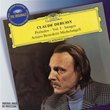| All Artists: Rued Langgaard, Stephen Layton, Thomas Dausgaard, Danish National Symphony Orchestra Title: Rued Langgaard: Symphonies 12-14 [Hybrid SACD] Members Wishing: 0 Total Copies: 0 Label: Da Capo [Naxos] Original Release Date: 1/1/2007 Re-Release Date: 1/30/2007 Album Type: Hybrid SACD - DSD Genre: Classical Styles: Historical Periods, Modern, 20th, & 21st Century, Symphonies Number of Discs: 1 SwapaCD Credits: 1 UPC: 747313151769 |
Search - Rued Langgaard, Stephen Layton, Thomas Dausgaard :: Rued Langgaard: Symphonies 12-14 [Hybrid SACD]
![Rued Langgaard: Symphonies 12-14 [Hybrid SACD]](https://nationalbookswap.com/cd//l/31/8131/6148131.jpg) | Rued Langgaard, Stephen Layton, Thomas Dausgaard Rued Langgaard: Symphonies 12-14 [Hybrid SACD] Genre: Classical |
Larger Image |
CD DetailsSimilar CDs |
CD ReviewsLate Romantic Music from the 1940s J Scott Morrison | Middlebury VT, USA | 02/11/2007 (4 out of 5 stars) "The phrase one keeps running into to when reading about Rued Langgaard (1893-1952) is that he was 'an odd duck.' And that he was. Born into an intensely musical family -- his father was a noted Copenhagen piano teacher and composer, his mother a fine pianist -- he started as a child prodigy, giving concerts from early on, studying in Berlin, having early orchestral works played by local forces and even in Berlin. But something happened to make him into a frustrated, bitter loner. Most likely this was because the Danish musical establishment, then in the thrall of Carl Nielsen, turned their backs on him. He lived with his mother until she died in 1926 and then married her housekeeper. He never got a steady job (as an organist) until his late 40s. And all the while he composed like crazy.
The three works presented here, part of a complete traversal of his 15 symphonies being recorded by Thomas Dausgaard and the Danish National Symphony Orchestra, are the Symphonies Nos. 12, 13 & 14. Unlike some of Langgaard's earlier more experimental works such as his best-known work, 'Sfaerernes musik' ('Music of the Spheres'), these are lush romantic works that partake very little of the European musical Zeitgeist of the mid-1940s when they were written. There is little here that couldn't have been written in the latter half of the 19th century. One hears echoes of Wagner, Schumann, Brahms and Denmark's own Niels Gade. The strangest thing about these works is not their sound-world but the half-crazy titles Langgaard gave to the separate movements, e.g., the last section of the 12th Symphony is 'Amok! A Composer Explodes!'. The 12th Symphony has an odd origin. In it Langgaard composes what is basically a seven-minute précis of his gargantuan 1st Symphony, a concept similar to that of those theatrical troupes that present, in one evening, all of Shakespeare's works in hyper-condensed form. Formally the work is a mishmash, but along the way there is some exceedingly attractive late romantic music. The main difference between the 1st and the 12th symphonies, aside from the latter's brevity, is that the 1st, written when Langgaard was in his teens, has an optimistic ending while the 12th ends with a furious outburst (the 'Amok!' section mentioned above). Symphony No. 13, subtitled 'Undertro' ('Belief in Wonders') is the lightest and most transparent music on this disc. Langgaard borrows themes from a couple of earlier works but there is no explanation for why he might have done this; perhaps he just liked the themes and thought they could benefit from further manipulation. The title 'Undertro' may be a pun based on the Danish word 'overtro' ('superstition') in some way referring to the unlucky associations with the symphony's number, thirteen. Whatever the case, this is a shimmering, vital work chockful of lovely melodies and orchestration. The seven-movement Symphony No. 14, subtitled 'Morgenen' ('Morning') starts out as if it is to expound on Langgaard's lifelong Theosophist beliefs, but becomes rather more mundane with sections called 'The tired get up for life', 'Radio-Caruso and forced energy', and 'Dad's rush to the office' presumably referring to the Danish man's need to get out of bed and drag himself to work. But the second movement, scored for strings alone, is called 'Unnoticed morning stars' and is one of the loveliest things of Langgaard's I've ever heard. And the brief finale, called 'Sun and beech forest' recalls the tranquility of the 'Morning stars' section and then builds to a climactic ending. Another feature of this symphony is that is calls for full chorus and indeed the first movement, 'Introductory fanfare', sounds like a Danish gloss on the opening chorus of 'Die Meistersinger.' The chorus reappears in that last movement, rather unconvincingly hymning to the words 'Long live beauty!' One oddity of this symphony is the nearly note-perfect quotation, in the second movement, of an aria from 'La Traviata.' What was THAT all about? Ah, well, this is a fine work that goes down well for all its oddities. The performances here are fine. I have not heard the competing recording by Ilya Stupel and the Artur Rubinstein Philharmonic on the Danacord label. The stereo layer's sound is just a shade below the best of today. I listened to this hybrid SACD issue in plain stereo only and cannot comment on the SACD sound quality. Scott Morrison" |


